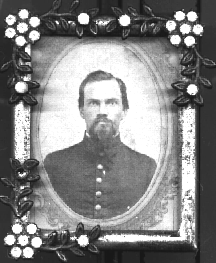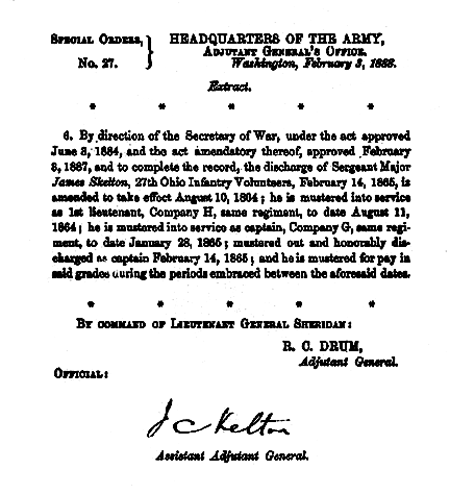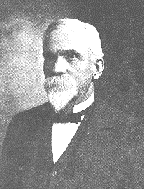
SKELTON FAMILY NEWSLETTER-IIe
No. 1b ------------------------------------------------------------------ 18 August 2000
------------------------------------------------------------------
Captain James Skelton (1836-1912) was a great-grandson of John Skelton (ca. 1750-1816) and his wife, Catharine Hepler (ca. 1751-ca. 1821), both residents of Shenandoah County, Virginia during their lives.[1] The following article summarizes Skelton’s experiences during the Civil War and his later difficulties with the Federal Government.
Details presented in the article are based on the Civil War diary of Captain Skelton and other extant documents of the era. A copy of the diary was kindly supplied by Mrs. Susan Ann (née Skelton) Randall of Jamestown, Ohio, a great-granddaughter of Captain Skelton. Susan is an art director and the mother of two: Erin, a senior in college, and David, who will start his college freshman year this fall, both at Wright State University, in Dayton, Ohio.
________________________________________
Captain James
Skelton and the Civil War

Captain James Skelton circa 1865.
In 1864, the United States Federal Government, to whom he had given almost four years of his life and in whose service he lost his lower right leg, let him down. In 1888, a quarter century later, the Government finally did the right thing.
He was among the first to answer the call to arms. On 19 July 1861, leaving a wife and infant son at home in Kelleys Mill, Lawrence County, then 26 year old James Skelton enlisted as a Sergeant in F Company, Twenty-seventh Regiment, Ohio Volunteer Infantry. One month later, he marched off with his regiment and spent the next two and a half years training, drilling, and doing battle with the enemy. The specific activities of the 27th during this period are reported in their regimental history[2] By the end of the year 1863, the regiment had been engaged in eight battles.
On Christmas Day 1863 in Prospect, Tennessee, Sergeant Skelton was mustered out of the army and then, along with the regiment, he re-enlisted for an addition three years, now as a "Veteran Volunteer" and as First Sergeant. After his re-enlistment, Skelton was furloughed home for a month and then assigned recruiting duties in Ohio. In March 1864, upon his return to the regiment, now encamped along the Tennessee River, near Decatur, Alabama, about twenty-six miles south of the Tennessee border, he began a journal. From its pages, we learn of the daily life of a soldier in the Army of the Tennessee[3] during the latter phase of the Civil War.
As reported by First Sergeant Skelton, the months of March and April 1864 were largely consumed with drilling, training, inspections, and report writings. But as April turned into May, the armies of the North, now under the unified command of Ulysses S. Grant, recently promoted to the rank of Lieutenant-General, began a campaign designed to defeat the two major Southern armies, the Army of Northern Virginia, commanded by General Robert E. Lee, and the Army of Tennessee, commanded by General Joseph E. Johnston.
Skelton’s outfit, the 27th O. V. V. I.,[4] was part of the Army of the Tennessee, commanded by Major-General James B. McPherson. This, combined with the Army of the Cumberland and the Army of the Ohio, represented about 100,000 men, all under the command of Major-General William Tecumseh Sherman. On 04 May 1864, Grant and the Army of the Potomac crossed the Rapidan River in Virginia, marching south and on this same day, Sherman began his invasion of Georgia. Sherman’s primary objective was the elimination of the Army of Tennessee. In May and early June, Sherman and Johnston engaged in an intricate series of maneuvering operations, Johnston would entrench before the advancing Yankees and Sherman would execute a complex series of flanking operations and eventually turn his flank, both sides avoiding a direct, head-to-head, confrontation in the open field. Sherman was penetrating deeper and deeper into Georgia, and closer to Atlanta, but Johnston’s army, the primary objective, remained unscathed. During this period, on June 1st, First Sergeant Skelton was promoted to Sergeant-Major of the regiment.
On June 27th, with the Rebels well entrenched behind log fortified earthworks on the slopes of Kennesaw Mountain, Sherman decided to attack. He launched a frontal assault against entrenched infantry and the result was a disaster - 4000 men were killed, three-quarters of whom were Union, but nothing was accomplished. In his diary on this day, Sergeant-Major Skelton wrote the following: "This was the day of the famous charge on Kennesaw and slaughter of the Union Army. I have often wondered why that charge was made and will now remark that if Sherman made a mistake on his march to the sea, I would call that mistake Kennesaw."(See the following Web site for additional details: http://ngeorgia.com/history/kennesaw.html.)
At about 2 A.M. on the morning of Tuesday, 28 June 1864, the war ended for Sergeant-Major Skelton. He was carrying an order along the front line from his regimental commander, Lieutenant-Colonel Mendall Churchill, when he was hit in the lower right leg by a minié ball.[5] The projectile fractured the bone in his lower leg, and sixteen hours later, at about noon of the 28th at a field hospital two miles behind the lines, his leg was amputated below the knee. Skelton spent the next eight months convalescing and on 14 February 1865, at the Washington Park Hospital in Cincinnati, Ohio, he received a disability discharge.
Ironically, in Columbus, Ohio on June 27th, the day before he was shot, The Honorable John Brough, Governor of Ohio, signed the document promoting Sergeant-Major Skelton to Second-Lieutenant Skelton. His commanding officer, Colonel Churchill, had recommended this action three weeks earlier. News of his promotion reached regimental headquarters after Skelton was shot and he never received his commission.
Because of the unusual circumstances, on July 12th, Colonel Churchill wrote to the War Department in Washington, requesting that he be permitted to muster out Sergeant-Major Skelton and muster in Second-Lieutenant Skelton and that he be carried on the rolls as an officer. The request was routed through the chain of command, receiving approval at every level, the last over the signature of Major-General McPherson on 15 July 1864.[6] But when the request reached Washington, and the offices of Secretary of War, Edwin M. Stanton, it was denied on a technicality: "The ‘rules of the Department’ require that every Officer & man mustered into the service shall be able bodied, and in no way disqualified from performing the duties of their positions."
There were people in Ohio who felt that Skelton deserved a better reward for his valor and years of service. On August 15th, Governor Brough promoted Second-Lieutenant Skelton to First-Lieutenant, and on January 28th, 1865, he promoted First-Lieutenant Skelton to the rank of Captain.
The details of what transpired between Captain Skelton and the Federal Government over the next quarter century have not (yet) been learned, but on 03 February 1888, Special Order No. 27 was issued, promoting Sergeant-Major Skelton retroactively to Second-Lieutenant, First-Lieutenant, and finally, Captain. And on 08 March 1888, The Honorable A. C. Thompson, U.S. Congressman from Ohio, requested that the Treasury Department render to Captain Skelton all appropriate back pay. The Government finally did the right thing.


Captain James Skelton circa 1903.
_______________________________________________
[1] The earliest known history of the family of John Skelton and Catharine Hepler, his wife, is reported in the following: Earl F. Skelton, “The John Skelton - Catharine Hepler Family: From the Shenandoah to the Midwest,” in National Genealogical Society Quarterly, Vol. 80, No. 4, 245-264 (1992).
[2] Whitelaw Reid, Ohio in the War: Her Statesmen, her Generals, and Soldiers, Vol. II, “The History of Her Regiments, and Other Military Organizations.” (New York, NY: Moore, Wilstach & Baldwin, 1868).
[3] Union armies were named after rivers and Confederate armies were named after places. Thus, the Union Army of the Tennessee [River] should not be confused with the Confederate Army of Tennessee [State], against whom they fought.
[4] O. V. V. I. = Ohio Volunteer Veteran Infantry
[5] The adjective “minié” is not related to the size of the ball, it is derived from the inventor of the projectile, Claude E. Minié, a Captain in the French army.
[6] Exactly one week after approving Colonel Churchill's request, General McPherson was killed — this was on 22 July 1864 during the Battle of Atlanta.
_________________
A complete version of the foregoing
article, including a transcription of the diary of Captain
Skelton will be available from the Lawrence County, Ohio
Genealogical Society (http://www.rootsweb.com/~ohlawren/index.htm); they also can be reached through the Briggs
Lawrence County Public Library, 321 South Fourth Street, Ironton,
Ohio 45638; mailto:genblc@oplin.lib.oh.us.
Have things changed?
Below is a copy of a photograph posted by Douglas McArthur (not: "MacArthur") on the National Veterans Organization web site (http://www.nvo.org). The photo appeared in an article entitled "Veterans’ Gripe Is Loud and Clear" and was published in The Washington Post on Thursday, 03 August 2000 (p. A27). The message speaks for itself.

________________________________________
Return to SFN-IIe Front Page
Read about the Skeltons of Scottsboro,
Alabama.
Read about Diana L. Skelton and the U.N.
Earl F. Skelton, Ph.D., CG
6311 29th Place, NW
Washington, DC 20015-2221
Edited by Lisa M.
Hightower-Chadwick
Camarillo, CA
Copyright © 2000 by Earl F. Skelton
All Rights Reserved. No part of this publication may be reproduced, in any form or by any means, including electronic reproduction or reproduction via the Internet, except by permission of the author.